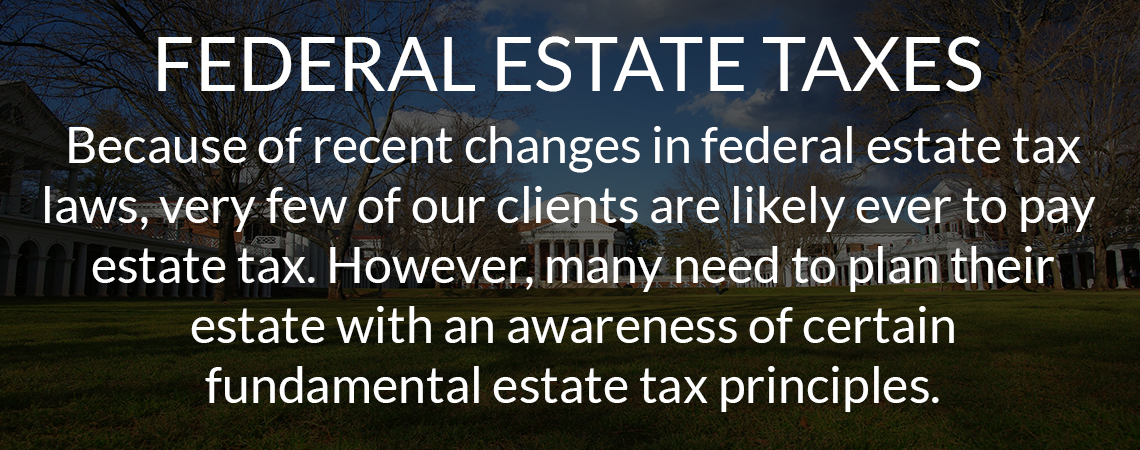
What are the key elements to the federal estate tax?
The federal estate tax is a tax on the transfer of wealth at death. Its younger brother, the federal gift tax, is a tax on the transfer of wealth during one’s lifetime. The federal estate tax has been part of American law since 1916. The gift tax was added later, in 1931.
Since 1981, the law has allowed a specific amount of a person’s estate to pass at death free of any estate tax. This is called the unified credit. Those same laws allow an individual to leave an unlimited amount free of any estate tax to a spouse who is also a U.S. citizen. This is called the marital deduction.
On December 2017, Congress passed and President Trump signed the Tax Cut and Jobs Act of 2017. One of the many provisions of this far-reaching legislation was to increase the unified credit amount (i.e., the per-person exemption) from $5 million to $10 million. The $10 million amount is indexed for inflation occurring after 2011. Thus for 2018, the per-person exemption is almost $11.2 million. Using "portability." which was added to the estate tax laws in 2013, a married couple with minimal tax planning can pass over $22 million to the next generation free of estate tax.
The per-person exemption is so large that estate tax concerns are non-existent for the vast majority of persons who are considering the transfer of their wealth during their lives or upon their deaths.
How did the Tax Cuts and Jobs Act of 2017 affect the federal estate tax?
On January 2, 2013, the Congress passed and President Obama signed legislation that established the unified credit amount (i.e., the per-person exemption) at $5 million, indexed for inflation occurring after 2011. Thus, for instance, in 2017 the per-person exemption was $5.49 million. Using "portability," which was added to the estate tax laws in 2013, a married couple with minimal tax planning could have passed almost $11 million to the next generation free of estate tax. For those who practice law in this area, this increase was almost unthinkable.
"Hold my beer" President Trump might have said when he signed into law the Tax Cut and Jobs Act of 2017. One of the many provisions of this far-reaching legislation was to increase the unified credit amount (i.e., the per-person exemption) from $5 million to $10 million, indexed for inflation occurring after 2011. In 2018, the per-person exemption is almost $11.2 million. Thus, a married couple with minimal tax planning can pass over $22 million to the next generation free of estate tax.
What is "Portability" in Estate Planning?
"Portability" was a revolutionary concept when it was introduced into the law for the first time ever in 2011. In 2013, the Congress and President Obama made "portability" a permanent feature of the federal estate tax laws.
Portability is a technique available to married couples to reduce estate taxes. It allows the surviving spouse to add the unused estate tax exemption of the first spouse to die to the surviving spouse’s estate tax exemption. In 2018, with proper planning, a married couple can now pass over $22 million to their children and grandchildren free of federal estate tax.
The law only provides one way to claim a spouse's unused exemption - by filing a federal estate tax return on IRS Form 706 for the estate of the deceased spouse and making the elections provided on that tax return. One unintended consequence - many estate tax returns are being prepared and filed that would not otherwise meet the filing threshold ($11.2 million in 2018) solely to make the portability claim. The requirements of Form 706 are lengthy and exacting. And there is no such thing as Form 706-EZ solely for portability filers. In for a penny, in for a pound.
Who is likely to use a by-pass trust?
A by-pass trust can also help ensure that a surviving spouse can avoid the “waste” of some a deceased spouse's estate tax exemption without resorting to portability and the filing of a federal estate tax return.
In typical by-pass trust planning, the first spouse to die will have established a by-pass trust (also referred to as an exemption trust or a credit shelter trust) in that spouse’s estate planning documents, to be funded only upon that spouse’s death, and only up to the amount of the decedent’s remaining exemption. The surviving spouse can be the beneficiary of the by-pass trust and the trustee, but it can have other beneficiaries and other trustees. Typically it provides that trust assets can be used for the support, maintenance, and health of the surviving spouse, terms which are interpreted generously under the federal estate tax laws and regulations.
However, in reality, there are many reasons why a first spouse to die might establish a trust for the surviving spouse that have nothing to do (any more) with estate tax concerns. It is often done for asset-protection purposes for the surviving spouse. In a second marriage, it is a method to provide for the surviving spouse during his or her lifetime, but to ensure the remaining trust assets are returned to the children of the first spouse to die.